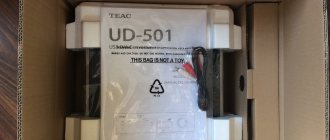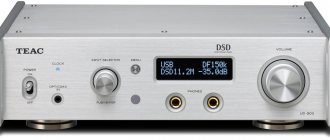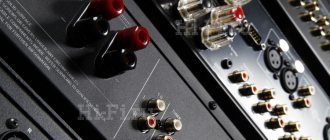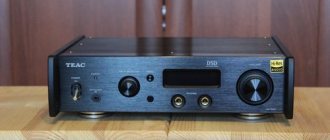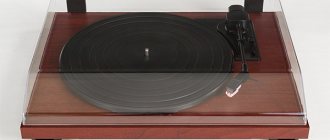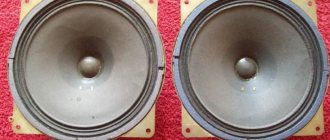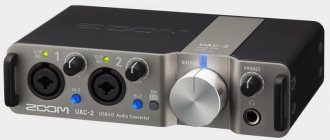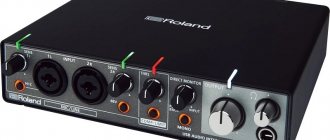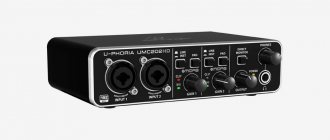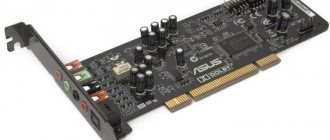TEAC UD-505-X and NT-505-X - high clarity of sound images in space!
The Japanese online magazine Phileweb (04.10.2021) published a brief overview of first impressions from a comparison of the new TEAC UD-505-X and NT-505-X models with the previous TEAC UD-505 and NT-505.
Review in pdf format
As is known, after a fire at the Asahi Kasei Microdevices factory, supplies of AK4497 DAC chips stopped and, according to forecasts, production is expected to resume no earlier than mid-2022. TEAC decided to use DAC chips from the no less reputable company ESS Technology. TEAC engineers installed one ESS DAC chip in each of the stereo channels. ESS Technology's reference DAC ES9038Q2M SABRE32 also has a strong reputation in the high-end audio market. The use of a 32-bit HyperStream ® II DAC architecture and Time Domain Jitter Eliminator (ESS original technology) has positioned it among the leaders in the high-end component market.
In addition to replacing the AKM DAC with an ESS, the new models have improved the TEAC-HCLD2 output buffer amplifier circuit (increased current compared to HCLD), the number of types of digital filters for PCM signals has been increased to 7, and the original design of the housing supports has been re-developed - without mechanical stress ( Stressless Foot). All this together made it possible to talk about a new generation of USB DACs, and the editors of the audiophile magazine Phileweb decided to compare them with previous models.
Here are the conclusions the author of the review, Tsunoda Ikuo, came to:
The sound features "high spatial clarity of sound images that demonstrate the full potential of DAC chips."
“What I felt was common when playing music with both the UD-505-X and NT-505-X was that spatial imaging and resolution were further enhanced. This can be said to be a result of the ESS as well as the dual mono architecture using separate DAC chips for the left and right channels.
“When I started recording “Silent Winter Night,” which is one of my reference tracks, the space in the reverb-rich church that was the recording location expanded noticeably, and I had the impression that the sense of depth was reproduced particularly well. The spatial reality of female vocals has also increased, the subtle nuances of the voice have become clearer, and variations in singing character as the singer's position changes are also well reproduced. The bass drum sound is great and powerful, and the bass is firm and woody. When playing the trumpet, I get the impression that the beautiful sound was presented especially close-up. In addition, in bell percussion, a beautiful thin sound spreads out wide to the left and right near the center. This also seems to be an effect of the new TEAC-HCLD2 buffer circuits, but my impression is that the reproduction of the weakest sounds is increased by the higher output current."
“Playback was carried out on the NT-505-X in combination with the fidata audio server, and on the UD-505-X, using the Roon software installed on a MacBook, which was connected to the USB input. If you dare mention the difference, the NT-505-X produces a slightly warmer tonal sound, while the UD-505X has a fresher sound tones.”
We recommend looking at the following models:
- DSD DAC/preamplifier/headphone amplifier TEAC UD-505-X. Black.
- Network player/preamplifier/headphone amplifier TEAC NT-505-X. Silver.
- Network player/preamplifier/headphone amplifier TEAC NT-505-X. Black.
- DSD DAC/preamplifier/headphone amplifier TEAC UD-505-X. Silver.
Outside
The 505 series is recognizable by its design - half-width, body with decorative “ears”, approximate indicator in the center of the front panel. The color can be silver, as in our case, or black.
The external design is of completely industrial quality, but it would be difficult to expect anything else from TEAC. There are even legs with their own vibration isolation through a cone - almost the same as those used in Esoteric devices.
Externally, the new phono preamplifier TEAC PE-505 completely fits into the design of the manufacturer’s 500 series. The device can be silver or black
The corrector is designed to connect only one head - however, the input switching is done in an unusual way. You can use a pair of RCA connectors plus a ground terminal, or an XLR input pair, if your phono cable is cut this way and the output from the tonearm is organized (some Japanese manufacturers use this cut).
However, there is a limitation - only an MC head can be connected to an XLR pair. But you cannot use two inputs at the same time - XLR and RCA, only one of them. The outputs look almost identical, but a full-fledged balanced output is declared. But here, too, you can only use one pair of output connectors.
Let's move on to something unusual - USB is located in the lower left corner of the rear panel. This is not a built-in ADC, as one might assume, but a connector designed to connect a phono stage to a computer and change firmware. Why this device needs firmware, I will tell you later, when we look at its internal structure.
The dial indicator is not only for beauty and continuity in terms of design, it has a number of quite pragmatic functions
The functionality of the proofreader is significantly richer than the statistical average. Basic "needs" include seven impedance values for MC heads, four capacitance values for MM heads, and a gain switch that can add 12 dB.
There is an XLR/RCA input switch, a mono/stereo switch and a low-pass filter from 17 Hz with a cutoff of 24 dB/oct. This is the usual functionality, but I must say that the range of adjustments is not small, and all other functions located on the front panel are accessible and very useful in practice.
And again, something unusual and valuable is switching correction curves. You can choose from RIAA, Decca and Columbia. This is not a complete list, but it is a useful function.
And it’s completely atypical that the dial indicator here is not only decorative. It is beautifully made, inherits the design of the 500 series, there is a brightness setting, or you can turn it off completely. The practical significance of the indicator is that it can be used to analyze the impedance of the MC pickup head - in fact, measure it.
It’s difficult to call this functionality paramount - after all, we usually start from passport data. But in some cases the function can be interesting and useful. And it works: I tested it on a couple of well-known heads - everything generally agreed.
The internal circuit of the TEAC PE-505 is definitely not simple.
The last feature worth mentioning is the built-in degausser, which the manufacturer suggests using for MC heads and step-up transformers. This option is not always needed, but it will also not be superfluous for some head models, depending on their design and materials.
Sound
The first one I played was Herbie Hancock's Sextant. The sound is of medium volume and scale - not exactly chamber-like, but not sweeping either. A little dry and restrained, but in terms of detail and dynamics - everything is better than expected.
The bass is fast, very intelligible, the variety in the sound of instruments in the lower third of the range is at an excellent level. However, the entire range is legible, everything is well divided in space, there is air and correct proportions.
The presentation can be described as emphatically correct, neat, very analytical, but without surgical corrosiveness. You can hear a lot of information in music, but it does not overwhelm the listener with its mathematics.
However, emotionality is also present, but the emotions do not put pressure on the listener - rather, there is an effect of delicate presence rather than complete immersion.
The next disc is one of the soundtracks for the Twin Peaks series in the form of a two-disc edition and mastered at Bernie Grundman Mastering Studio.
Rear panel TEAC PE-505. The circuit design of the device is balanced, and in addition, to work with MC heads, you can also use the input on XLR connectors
In terms of presentation, it’s detailed, precise, with good volume, but the sound is rather strict. There is a certain emphasis on the main tones and the retreat of aftertones into the background. The emotionality is restrained, although in general everything is present, nothing is turned upside down or altered. Elasticity, rhythm at a good level, presentation of the range is smooth and confident.
With good volume, the sound is perceived as solid, without complex textures and nuances. Air is present in the sound, but not clearly expressed. The individual components do not really attract attention; the emphasis is on the whole.
The dynamics are good and confident. Not emphasized, but not at all flaccid. In general, the sound tends slightly towards a monitor sound, it is difficult to find any coloration in it, and some pedantry and even strictness of presentation smooth out the detail and textures, without simplifying the sound.
Standard vibration decoupling leg with a cone and a response platform inside. Everything is almost the same as with much more expensive Esoteric devices
Another disc is the John Coltrane album “A Love Supreme”. The sound is not devoid of delicacy, but still rather strict and mathematical. There is a well-practiced rhythm and a timbre-reliable presentation. There is detail - everything here is quite honest.
But the texture of quiet sounds, those nuances and shades that make the sound of this album almost visually understandable are a little lacking. What we get here is more of a verified drawing - a diagram, rather than a painting.
However, I would not seriously talk about the lack of detail. It is present, but all the characteristics of the sound are mixed in exactly the same proportions and ratios.
If the details, dynamics and lack of coloring have already become clear, then the transfer of atmosphere, mood, emotions and other subtle and ambiguous components still remains to be sorted out. I put on a record with the soundtracks to “Mirror” and “Stalker” - these recordings are somewhat unclear in terms of the requirements for the path.
The functionality of the corrector is clear, understandable and easy to use
Detailed, dynamic, generally legible, but not very textured. The volume of sound is not chamber-like, but not very large either - rather a little more than average. There was a little lack of air, and the sound again seemed rather dry and stern.
In terms of the tonal balance, only on this record it seemed that the mids and highs were somewhat elevated, but adjusted for the recording itself, we can say that the device worked well. A little managerial - technical, but with restrained emotions. In working mode.
And the last record from the main lineup is a recording of Stravinsky’s works, namely “Die 3 Grossen Ballette”. Here the conditions are not at all simple in terms of detail and dynamics. But the TEAC PE-505 coped well with detail and dynamics - definitely better than many devices of a similar class and a slightly higher class.
On complex fragments, the elaboration of musical material is confident. The sound is timbrally reliable, and the instruments sound quite believable. But again, everything is a little dry and mechanical - with the correct layout of the stage and its good volume, there is a little lack of air and texture.
However, this is judging by the sound level, which is generally difficult to find fault with, and this is the sound of much more expensive correctors than our test subject. He did his job very well, confidently, carefully to the point of pedantry - perhaps somewhat restrained in his emotions.
Inside
Now let's look inside the phono stage. The power supply is linear, and also divided into two groups according to a pair of small toroidal transformers. As I understand it, a division is intended here into the signal part of the phono preamplifier itself and separately into the entire service part, as well as into the control system.
And this control already gives an understanding of why the device has firmware and USB for connecting to a computer. The correction circuit is complex, and if it were not assembled using fairly compact SMD parts, the device would definitely require a full-size case. And to this whole discrete circuit is added processor control.
I specifically checked with the manufacturer whether some kind of conversion of the main signal is used in the device, but no - the main signal remains analog. But the processor controls the functionality: switching curves, measuring functions and settings.
The solution is interesting, but resource-intensive. However, a large manufacturer associated with the production and development of not only TEAC, but also Tascam and Esoteric, has the capabilities to design such circuitry.
I received the device completely new, and for some time I decided to let it break in. There is a warming up effect, but not dramatic - and it won’t take much time. However, with such an elemental base this was to be expected.
I didn’t have any special time restrictions, and I could easily listen to the device in different conditions and combinations. Based on this experience, I can say that the proofreader is not at all capricious, predictable, and generally without any oddities. And very, very quiet.
Although there is almost never any noise in my system, you can still notice the difference depending on the device and circuit design. The TEAC PE-505 is perhaps the quietest phono stage I've come across over the past year.
The processor that controls the functionality of the device
One of the noticed features is that before listening, it still needs 20 minutes to get into working mode. It’s not critical, but if possible, it’s better to turn it on a little in advance.
conclusions
The first thing you should pay attention to here is functionality. It is significantly above average, and most importantly, it is comfortable. Once you figure out the switching, everything else is available on the front panel - convenient and clear. The second is, of course, an interesting processor-controlled architecture. All this, in general, is much more friendly to the owner than those devices whose settings are hidden somewhere in the body.
Some features: low background level, lack of coloration and a choice of correction curves may appeal to those who digitize vinyl or want to do it at the advanced amateur level. If everything before and after the corrector is at least at the same level, the result will be much better than the average analog-digital garbage on the network.
Now about the sound. Rhythm is this phono preamp's strong suit. There is virtually no coloring, it is impossible to find fault with any part of the range, and also with the proportions of the components of the range. The sound of the device is clear and predictable; in no case are there any oddities noticeable in it. Well, the rigor and certain mathematical presentation will undoubtedly also appeal to someone.
